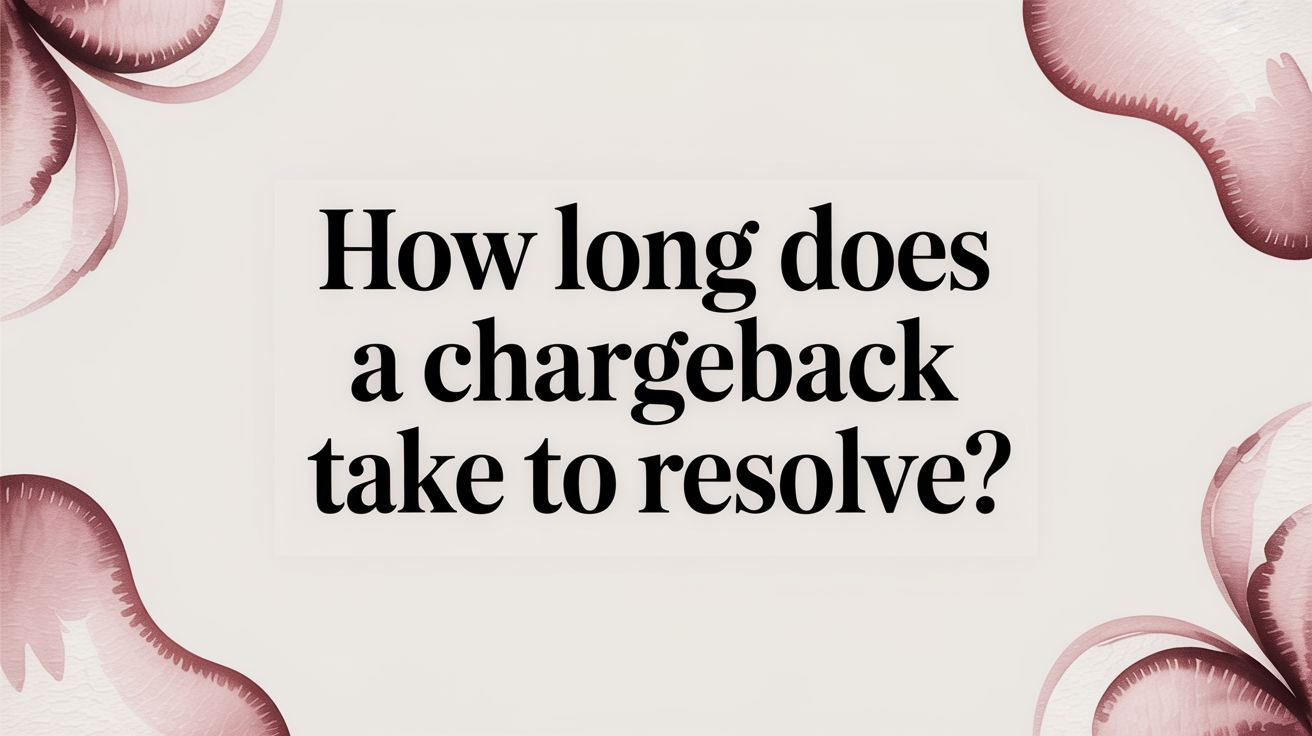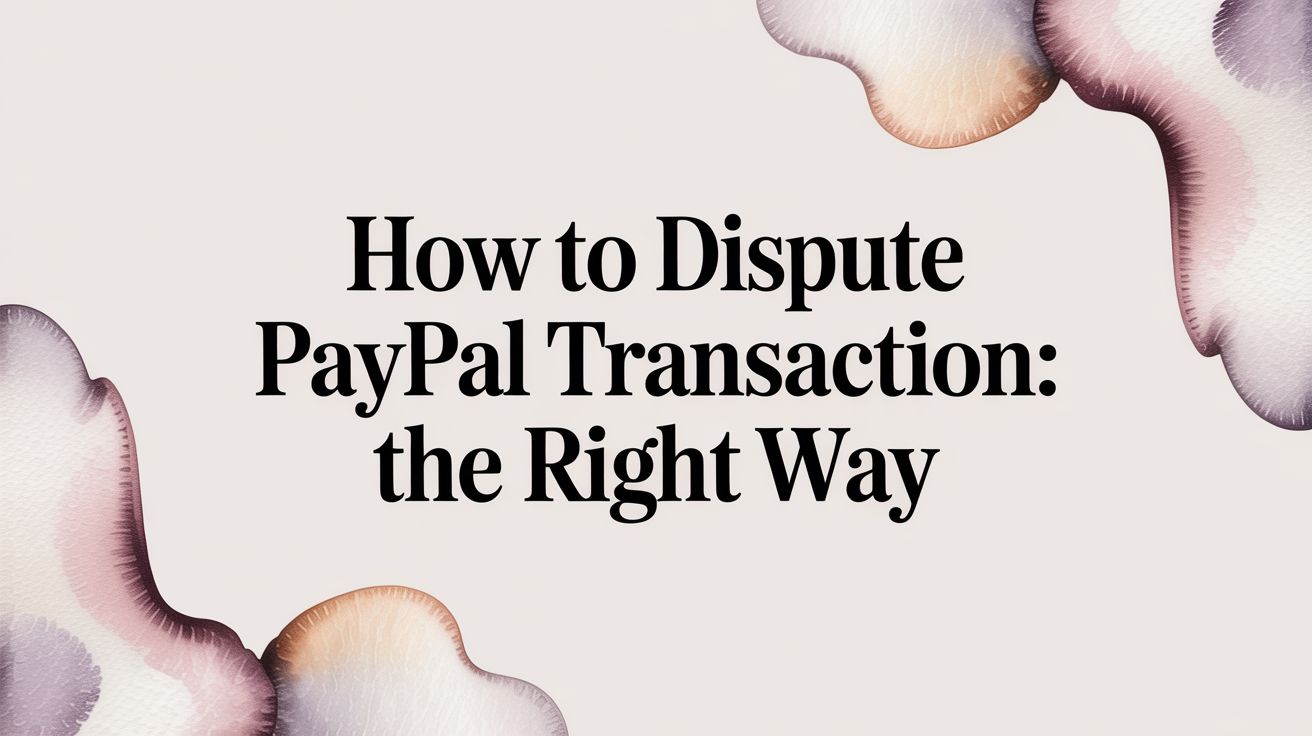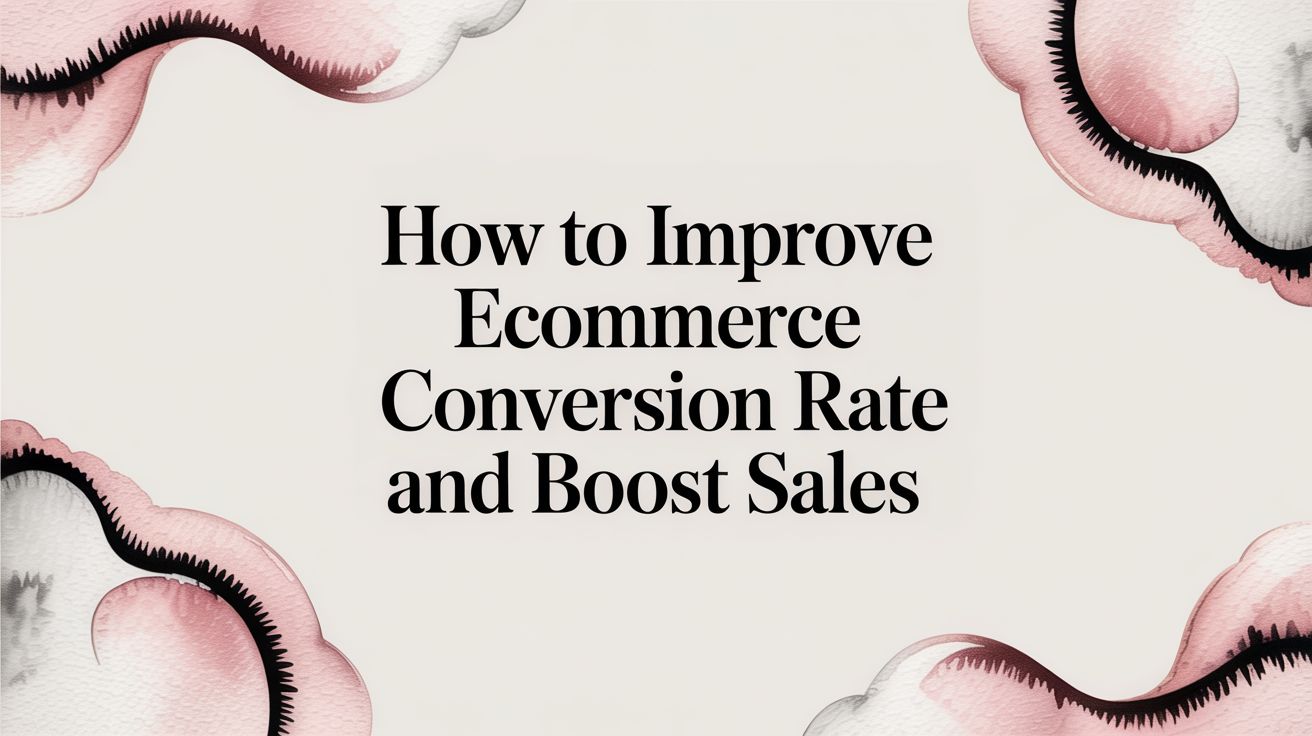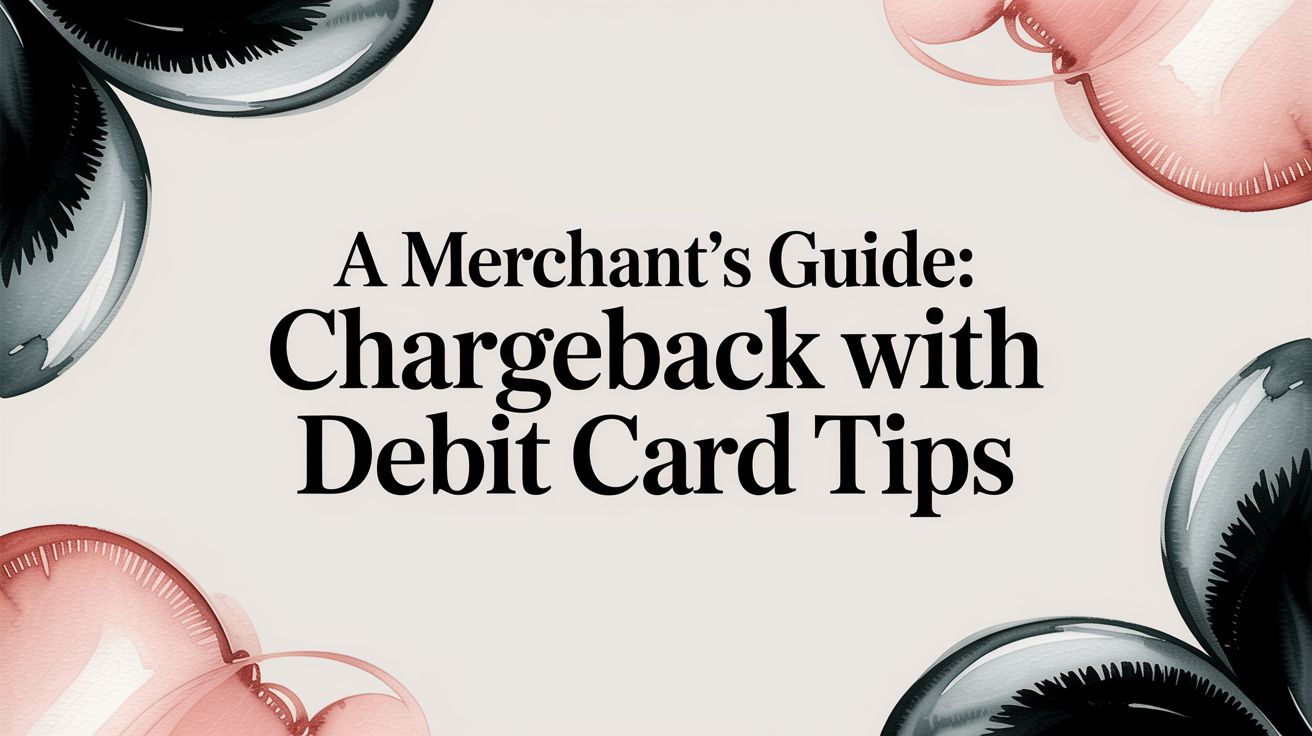
When you get hit with a chargeback, the first question is always the same: how long is this going to take? The short answer is that a typical chargeback process takes anywhere from 30 to 90 days from the moment it's filed until you have a final decision. But sometimes, it can drag on for even longer.
Your Quick Guide to the Chargeback Timeline
Think of the chargeback process less like a single event and more like a journey with multiple stops. It involves several key players: the customer, their bank (the issuer), the card network (like Visa or Mastercard), your business, and finally, your bank (the acquirer). Each step has its own timeframe, and they all add up.
This entire journey is governed by strict rules and deadlines set by the card networks. For example, while the whole process might take a couple of months, networks like Visa give customers up to 120 days just to start the dispute. Getting a handle on these different stages and their deadlines is the first step to managing the process without pulling your hair out. You can learn more about the critical details of the chargeback time limit to make sure you never miss a deadline.
A chargeback isn't a quick fix for a customer issue. It's a formal, often lengthy, banking procedure designed to protect consumers from unauthorized transactions or merchant errors.
The total timeline really hinges on a few key factors:
- Card Network Rules: Visa, Mastercard, and American Express each have slightly different timelines and rules.
- Case Complexity: A simple billing error will get sorted out much faster than a complex claim of fraud or an item not being delivered.
- Response Times: How quickly you, the customer, and the banks respond at each stage makes a huge difference. Delays can add weeks to the process.
To give you a clearer picture, here’s a simplified breakdown of what to expect.
Chargeback Process at a Glance
This table offers a bird's-eye view of the typical chargeback stages and how long each one usually takes. Keep in mind these are estimates, and your experience might be different depending on the specifics of the case.
Ultimately, this entire process can feel slow and frustrating, especially with your revenue on the line. But knowing what to expect can make a world of difference in how you manage it.
The Chargeback Journey From Start to Finish
Think of a chargeback as a relay race with four runners, each passing the baton from the customer all the way back to your merchant dashboard. Every handoff is timed, with strict deadlines set by the card networks (like Visa or Mastercard) to keep the process fair and orderly for everyone involved.
Understanding these stages is key to answering the big question: how long does a chargeback take? Most of the time, you're looking at a window of 30 to 90 days. But that timeframe can stretch or shrink depending on the card network, how complex the case is, and how quickly everyone responds.
Let's walk through each leg of the journey so you know exactly what’s happening and when.
Dispute Initiation
The starting gun fires the moment a customer contacts their bank (the issuer) to dispute a charge on their statement. The bank does a quick check to see if the reason is valid and often gives the cardholder a provisional credit.
This first leg is usually pretty quick, lasting just 1 to 5 days, but it officially gets the ball rolling. Once the bank validates the dispute, it’s sent through the card network to move to the next stage.
Acquirer Review
In this leg, the baton is passed from the card network to your bank (the acquirer). Your bank’s job is to verify the claim, debit the disputed amount from your merchant account, and log the official reason for the chargeback. This review typically takes another 5 to 10 days.
Once they're done, you'll get a notification with all the details—the chargeback reason code, the amount, and the deadline to respond. A heads-up: if that notification is incomplete or missing key data, it can easily tack on an extra week or two to the process.
Merchant Representment
Now the baton is in your hands, and the clock is ticking. This is your one shot to fight the chargeback by compiling and submitting evidence that proves the transaction was legitimate. This is where things like shipping confirmations, delivery photos, and customer service emails become your best friends.
Merchants generally have 20 to 45 days to build their case and send it back. Don't let that timeframe fool you into procrastinating. You need to be organized and fast to avoid an automatic loss.
Your evidence file should include things like:
- Proof of delivery records (with tracking numbers)
- Transcripts or screenshots of customer communications
- A clear copy of your refund or return policies
- Transaction logs and digital receipts
Want to build an airtight case? We break down more winning strategies in our chargeback representment guide.
Industry reports show that merchants who respond within the first 10 days win 54% of their disputes. Speed really does matter.
Final Decision
Once you submit your evidence, the case goes back to the customer's issuing bank for the final verdict. They'll review everything you sent and make a binding decision. Under normal circumstances, you can expect this final review to take 20 to 40 days.
If you (or the cardholder) disagree with the outcome, the case can be pushed into arbitration. This is like the final, tie-breaking lap, and it can add another 45 days to the timeline.
Knowing what happens at each stage helps you anticipate the total time you’ll have funds tied up and lets you manage your resources better.
And remember, different payment platforms have their own quirks. For a deeper dive into a specific processor, you can find helpful details on PayPal chargeback disputes.
The bottom line? Keeping a close eye on deadlines can shave days or even weeks off the total timeline. In fact, automating alerts for each phase can cut resolution time by an average of 15%.
Why Some Chargebacks Take Longer Than Others

You've probably noticed that no two chargebacks seem to follow the same schedule. One might be over and done within a few weeks, while another drags on for months, seemingly stuck in limbo. This isn't just random chance—specific factors can either speed a chargeback up or send it down a much slower path.
The single biggest variable is the chargeback reason code. Think about it: a straightforward issue like a duplicate transaction is pretty easy for a bank to verify and close out. But when a customer claims "product not as described," it suddenly requires a deep dive into evidence from both sides. That kind of investigation just takes more time.
Key Factors That Slow Things Down
It helps to think of the chargeback process as a conversation between banks. If the message is clear and the evidence is solid, the conversation is short. But if things are muddy or incomplete, it’s going to involve a lot of back-and-forth, adding weeks to the timeline.
Several common bottlenecks can pop up and cause delays:
- Weak Evidence: If you submit blurry screenshots, patchy shipping details, or vague customer service notes, the issuing bank is almost guaranteed to come back with questions. This back-and-forth is a massive time-waster.
- Card Network Rules: Visa and Mastercard have their own distinct deadlines and procedures. The complexity of these rules can add extra layers to the process, especially if a case gets bumped up the chain.
- Communication Gaps: Delays often happen when information doesn't move smoothly between your bank, the card network, and the customer's bank. A simple administrative hiccup at any point can put the entire process on pause.
The quality of your representment package is the single most important factor you can control. A well-organized, compelling case can prevent the need for further review, shaving weeks off the final decision time.
Escalations and Their Impact on Time
If either you or the cardholder disputes the initial decision, the case can move into a more formal stage. This is where the timeline can really start to stretch out, as it requires a much deeper level of review from the card networks.
This escalation is a huge reason how long a chargeback take can vary so much. For merchants facing this kind of second review, understanding the ins and outs of the pre-arbitration process becomes essential. This advanced stage comes with additional fees and can easily extend the resolution by another 30 to 45 days, turning what was a two-month problem into a four-month ordeal.
What the Data Says About Chargeback Timelines
The official chargeback timeline can feel a bit theoretical, but real-world data paints a much clearer picture of what you're actually up against. The numbers don't lie: once a dispute is filed, it rarely just disappears. More often than not, it escalates, and the odds can feel stacked against you.
Let’s dig into the process. The journey from a customer's initial complaint to a final decision is really a funnel. Most issues pass right through the early stages and land squarely in the formal chargeback process. This is a critical point to grasp when wondering how long does a chargeback take, because every escalation adds more time to the clock.
The Chargeback Funnel in Action
Data from Mastercard's State of Chargebacks report gives us a fascinating, and frankly, sobering breakdown of how this plays out. A tiny 8% of cases are resolved at the early, pre-dispute stage. While issuers discard another 18%, a massive 74% escalate into formal chargebacks that land on your desk.
From that point on, the numbers tell an even more compelling story:
- Merchants simply accept the loss on 46% of these formal chargebacks.
- The remaining 54% of merchants decide to fight back and enter the representment process.
- Of those who actually fight, merchants win only about 20% of the time.
Think about that for a second. For every 100 initial disputes, only about 11 are ultimately won by the merchant through representment. This really hammers home why you need a rock-solid, evidence-backed case right from the get-go.
This data underscores just how essential a proactive and organized response is. With such a slim chance of winning a contested case, every single piece of evidence and every day you can save in the process really counts. To better prepare your business, you can explore more chargeback tips and statistics and arm yourself with knowledge.
How E-commerce Growth Is Clogging Up the System

The incredible boom in online shopping has a direct, and often frustrating, impact on how long it takes to resolve a chargeback. As more and more people click “buy now,” the number of transaction disputes naturally goes up with it, putting a huge strain on the entire system.
This isn't just a small increase; it's a massive wave of new cases flooding the banks and card networks every single day. Think of it like a highway during rush hour. When too many cars (disputes) hit the road at once, everything slows to a crawl. The time it takes to get to your destination—a resolution—gets longer for everyone.
The Growing Backlog
The numbers really paint a clear picture of this growing headache. Global chargeback volumes are expected to hit about 261 million and are on track to climb to 324 million by 2028. That's a staggering 24% growth in just a few years, which means more disputes are clogging up the pipeline.
This rising tide of cases directly impacts how long a chargeback takes to resolve. With more disputes to investigate, the teams at the banks are stretched thin, which leads to delays at every single stage of the process.
The reality for merchants is that these external pressures are stretching out wait times. You can't control the global volume of disputes, but you absolutely can control how efficiently you manage the ones that land on your plate.
Why Your Internal Process Matters More Than Ever
Because of this system-wide slowdown, having a sharp, streamlined internal process for handling disputes is no longer a "nice-to-have"—it's a must. A slow or disorganized response on your end will only make the delays worse.
Here’s what this trend really means for your business:
- Longer Wait Times: You have to be prepared for resolutions to take longer than they did a few years ago. It’s just the new reality.
- Evidence is Everything: With investigators juggling heavy caseloads, your evidence needs to be crystal clear, concise, and compelling. This is what gets you a faster, favorable decision.
- Efficiency is Non-Negotiable: Automating your response process helps you hit every deadline without fail. This prevents you from losing disputes simply because you were too slow.
Understanding the direct link between your sales volume and your e-commerce chargeback rate is the first step in getting ahead of these challenges and protecting your business.
Got Questions About Chargeback Timelines? We've Got Answers.
When you're dealing with a chargeback, it can feel like your money is stuck in limbo. Time drags on, and clear answers are hard to come by. Let's tackle some of the most common questions merchants have about how long this whole process takes and what you can actually do about it.
Can I Do Anything to Speed Up the Process?
While you can't magically change the deadlines set by the card networks, you absolutely have control over preventing delays on your end. The single best thing you can do is respond to every chargeback notification immediately and with rock-solid evidence.
Don't wait until the last minute. Get your compelling evidence submitted well before the deadline. This is where a good chargeback management tool can be a lifesaver—it helps automate gathering and submitting everything you need, so you never miss a critical window that results in an automatic loss.
What Happens If I Miss the Response Deadline?
Honestly, this is one of the worst mistakes you can make. If you fail to respond within the required timeframe—which is typically between 20 and 45 days—you automatically lose the dispute. Period.
The funds are gone for good, returned to the cardholder, and you lose any right to fight the decision. This is exactly why being fast and organized is non-negotiable for every single merchant.
Think of the response deadline as a point of no return. Once it passes, your opportunity to recover that revenue is gone forever. Being proactive isn't just a good idea; it's your only defense.
Does the Reason for the Chargeback Change the Timeline?
Yes, absolutely. The reason code attached to the chargeback plays a huge role in how long things will take.
A dispute for a simple, clear-cut issue like a duplicate transaction might get resolved pretty quickly. The evidence is straightforward and easy for a bank to verify.
But then you have disputes for things like "services not as described" or "product not received." These are way more complex. They require a mountain of detailed evidence from both you and the customer, which naturally means a longer, more drawn-out investigation before you get a final answer.
Tired of manually fighting chargebacks and losing revenue? ChargePay uses AI to automate the entire dispute process, generating winning responses to recover your funds hands-free. See how much you can reclaim at https://www.chargepay.ai.







.svg)







.svg)
.svg)
.svg)